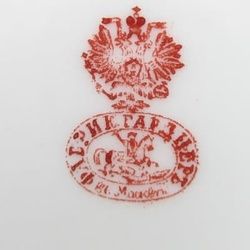
В марте 1766 года состоялось официальное открытие фабрики осевшим в России шотландским купцом Фрэнсисом (Францем) Гарднером. Хотя само производство было организовано раньше, в 1754 году, когда земля с селом Вербильцы принадлежала князю Николаю Урусову.
Прежде чем открыть свою фабрику, Гарднер много поездил по России - от Соловков до Сибири, выискивая особую глину для фарфора. Лучший вариант он нашёл в уже знакомой ему Малороссии - на Черниговщине (так называемую «глуховскую»). Решив вопрос с сырьём, Гарднер дал обещание «завалить» Империю собственной фарфоровой посудой, дабы не платить за импортную (например, мейсенский фарфор). В организации фабрики принимали участие старший сын Гарднера и профессор Женевского Университета Франц Гаттенберг, иностранец, которого вскоре вызвали в Петербург для заведования Императорским фарфоровым заводом.
В 1777-1783 годах было изготовлено для императрицы Екатерины II четыре орденских сервиза Георгиевский, Андреевский, Александровский и Владимирский. Все они были предназначены для приёмов в честь кавалеров этих орденов. Первый же сервиз очень понравился Екатерине II, и Гарднер удостоился высочайшей аудиенции. Сразу после приёма «на самом верху» московский генерал-губернатор пожаловал Гарднеру право ставить на его изделиях изображение московского герба, своё покровительство шотландскому коммерсанту обещал и бывший управляющий Императорским фарфоровым заводом князь Юсупов.
Гарднер понимал, что нужно развивать разные направления, и параллельно с эксклюзивным, начал развивать массовое производство.
Фарфор изначально был европейским, так как первых мастеров Гарднер пригласил из прославленного Мейсена. Одним из них был Иоганн Миллер, успевший поработать и на Императорском фарфоровом заводе под руководством Дмитрия Виноградова. Наряду с эксклюзивом, предназначенным для императорских дворцов и домов высшей аристократии, Гарднер, обладавший прирождённым даром к коммерции, наладил и массовый выпуск фарфоровой посуды. Она высоко ценилась в России, и многие, кому не по карману было покупать импортный саксонский фарфор, охотно приобретали «родной», гарднеровский. Пришлось расширять производство: если в 1771 году на заводе в Вербилках работало 70 человек, то за десятилетие это количество удвоилось. Причем из полуторы сотен сотрудников лишь управляющий и художник были иностранцами.
Когда Франц Гарднер умер, его детище считалось лучшим частным фарфоровым заводом в России. Дело продолжили наследники, в частности завод перешёл старшему сыну Францу Францевичу, ненадолго пережившему отца. Затем к жене Гарднера, Сарре Александровне, которая не смогла должным образом распорядиться наследством. В начале 19 века фабрика переходит к её сыновьям, Александру Францевичу и Петру Францевичу, сумевшим возродить производство.
С 1833 фабрика освоила выпуск посуды из фаянса, а в 1840-х годах - из опака (высший сорт фаянса). Гарднеровский фарфор стал эталоном для других частных русских заводов.
В 1829 году фабрика получила золотую медаль на Первой промышленной выставке, а в 1855 году — особую благодарность императора и почётное право ставить на изделиях изображение теперь уже государственного двуглавого орла. В Российской империи это был эквивалент знака качества. Право использовать изображение Государственного герба России на продукции «Мануфактур Гарднеръ» было подтверждено в 1865, 1872, 1882, 1896 годах. С 1856 года фабрика «Мануфактур Гарднеръ» обладает званием «Поставщик Двора Его Императорского Величества».
В середине 1850-х годов фабрика переходит к Владимиру Петровичу и Александру Петровичу, внукам Франца Гарднера. Затем, к концу 19 века, владелицей становится жена третьего брата, Павла Петровича, Елизавета Николаевна Гарднер, которая в итоге и продала фабрику.
Однако во 2-й половине 19 века художественный уровень изделий завода деградирует. Засилье шаблонных приёмов росписи, введение переводных картинок (декалькомании) с репродукциями салонной живописи, расчёт на коммерческий успех приводят к упадку пластической и декоративной культуры. Некоторую самобытность сохраняют лишь «восточная» (для Средней Азии) и «трактирная» посуда с яркой праздничной росписью и отдельные выставочные изделия, выполненные по эскизам художников. Ещё из возможных причин: обострение отношений с Британией после Крымской войны (в этот период на имущество «британско-подданных» накладывались аресты) и неспособность наследников Гарднера «притереться» к специфике отечественного бизнеса.
В середине 1880-х годов на фабрике с 777 рабочими производилось фарфоровых изделий на 208 тысяч рублей.
Аукцион искусства и старины art-picture.ru предоставляет возможность покупки
приобрести представленны лоты по теме "Мануфактура Ф.Я. Гарднера"










